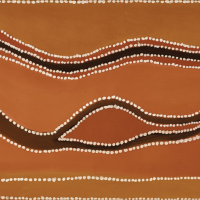64. ROVER THOMAS (JULAMA)

Rover Thomas (Julama) was born at Yalda Soak in the Great Sandy Desert near Kunawarritji (Well 33) on the Canning Stock Route in Western Australia. Following his mothers death, Thomas was trained as a stockman in the Kimberley region at Billiluna cattle station in the Tanami Desert, between Balgo and Halls Creek. In 1975 he settled at Warmun (Turkey Creek), where he is credited with pioneering the critically acclaimed East Kimberley painting movement in the period 1979-82.
Judith Ryan characterises Thomass approach as fusing the cosmic with the concrete, condensing complex mythological and topographical information into simple abstract elements on the surface of the canvas;1 his landscapes and narratives imbued with the presence and mystery of the Narungani, or creative past.2
Thomass mixed artistic heritage of the pictorial traditions of the East Kimberley (Gija/Miriwoong people) and his western desert culture (Wangkajunga/Kukatja), are evident in his compositions. These are marked by lines of dots, used traditionally in the Kimberley to delineate icons and figures,3 and now employed to demarcate country. It was this stylistic dissonance4 elsewhere categorised as a creative paradox5 that propelled his work to the forefront of the East Kimberley movement and onto the world stage.
It is recorded that Rover Thomas had a fond nostalgia for Texas Downs. Lally Creek 1991, along with All that Big Rain Coming from Topside 1991 (National Gallery of Australia collection, Canberra), depict waterbodies on the station, where Thomas and his co-workers would seek relief from the long days of hard mustering.6 The central narrative of Lally Creek relates to a waterhole, kangaroo hunting and encampment site, beneath an expansive hillside. This striking painting exhibits the hallmarks of virtuosity and compositional restraint, consistent with other examples from 1990-91, including massacre works held in the collection of the National Gallery of Australia.
Rover Thomas was known for his deep consideration of the natural pigments selected for his works. As Mary Mcha once summarised, Rover has taken the pigments and shown you the country.7 Thomas depicts the Lally Creek site in his iconic planar perspective stripped to bare bones.8 Its sumptuous layers of sunbaked sand and earth have been created with matte pigments. The subtle tonal shifts contrast dramatically with the shadows of the hills and the dotted creek lines to create a tension across the picture plane.
In 1990, less than ten years after he famously declared to Mary Mcha, I want to paint,9 Thomas received recognition and status amongst the countrys premier contemporary artists. He was selected as Australias representative to the 44th Venice Biennale, along with Trevor Nickolls (1949-2012), the first Indigenous artists to be accorded this honour. The same year, he won the acquisitive McCaughey Prize at the Art Gallery of New South Wales. In 1992, his work featured in Crossroads Towards a New Reality: Aboriginal Art in Australia (National Museum of Modern Art, Tokyo), and two major public gallery solo exhibitions followed: Roads Cross, The Paintings of Rover Thomas, in 1994 (NGA); and posthumously, I Want to Paint in 2003-04 (AGNSW).
Footnotes:
1. Ryan, J., Rover and Queenie [exhibition brochure], National Gallery of Victoria, Melbourne, 2000, n.p.
2. Caruana, W., Roads Cross, The Paintings of Rover Thomas, National Gallery of Australia, Canberra, 1994, p.3
3. Quaill, A., The Eye of the Storm: Eight Contemporary Australian Indigenous Artists, National Gallery of Australia, Canberra, 1997, p.92
4. 1990 Venice Biennale, Australia. Artists: Rover Thomas - Trevor Nickolls, Art Gallery of Western Australia, Perth, 1990, p.13
5. Christenson, W., Rover Thomas: I Want to Paint, Art Gallery of New South Wales, Sydney, 2004, p.61
6. Cubillo, F., and Caruana, W. (eds.), Aboriginal and Torres Strait Islander Art: Collection Highlights, National Gallery of Australia, Canberra, 2010
7. Mary Mcha, quoted in Rover Thomas [exhibition brochure], Holmes Court Gallery, Western Australia, 2000, n.p.
8. Ryan, J., op. cit.
9. Introduction: Mary Mcha and Don McLeod interviewed by Duncan Peppercorn, in Rover Thomas: I Want to Paint, op. cit., p.49
Jane Raffan
Jane Raffan is an accredited valuer under the Commonwealth Governments Cultural Gifts Program. Her arts consultancy encompasses curatorial services, collection management, and a broad range of humanities-based research and writing.